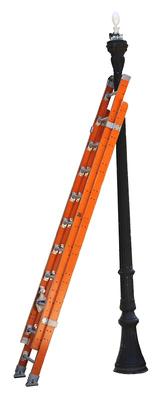Do-it-yourself homeowners are notorious for home improvement mishaps. From hammered fingers to bruised shins, there is no end to the ways that home owners can find to injure themselves while remodeling their homes.
One of the most dangerous positions a home owner can find himself in, however, is on a ladder. Ladders are inherently dangerous as they can be unstable and falling from one can result in serious injuries. The next time a ladder is needed for the job, follow the seven tips below to ensure that you will remain safe and injury free.
Tips for Ladder Safety
(Tip 1) Never use a ladder if you are feeling weak, dizzy or are under the influence of alcohol. Your odds of ending up in the hospital emergency room are much greater if you attempt to use a ladder when you are not of sound mind and body. Do not take the risk; save the ladder climbing for another day if you are not feeling well.
(Tip 2) Forget the flip-flops! Work boots or sneakers with a good, non-slip grip are essential. A fall can easily happen if your foot slips on a rung.
(Tip 3) Use a ladder that is the right size and shape for the job being done. Roof work will most likely require an extension ladder, while changing the porch light bulb can be done with something smaller. A ladder that is too short will cause you to stretch and become unbalanced. A ladder that is too tall has a better chance of becoming more unstable and falling over. Make sure that the ladder’s height corresponds to its job.
It is also important to make sure that the ladder is rated for your weight. A 300-pound man who attempts to use a ladder rated for less than 200-pounds is putting himself in a precarious situation.
(Tip 4) Keep it level. Choose a solid, level location to set up the ladder. If the ground is soft or rocky, the chances of the ladder tipping are much higher. It is also important to watch the top resting point of an extension ladder to make sure that it too is against a flat, firm surface. The sturdier the ladder is, the safer it will be.
(Tip 5) Avoid using a ladder in wind or rain storms and near electrical wires. These conditions present unnecessary dangers that make ladder use unsafe. Avoid them at all costs.
(Tip 6) Hand over hand, rung over rung. Never try to skip a rung as you climb the ladder; take each rung one at a time. This will cut down on the chances of you slipping, as well as, falling off the ladder.
(Tip 7) Have a spotter. Many do-it-yourself homeowners pride themselves on doing the job alone. When it comes to ladder safety, though, have a partner. Although only one person should ever be on a ladder at a time, the spotter is there to hold the ladder steady and provide help should the need arise. The spotter should have a cell phone on hand in case there is a need to call for help.
Above all, when using a ladder, use common sense. Be careful and diligent about your safety. No crown molding installation, roof repair or paint job is worth risking a life.


